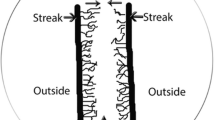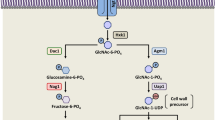Abstract
When grown and induced to form germ tubes in liquid defined media, yeast cells of Candida albicans must reach stationary phase before acquiring ability to carry out the yeast-mycelial transition. This study examined the effect of the carbon source utilized for yeast growth on the inducibility of stationary phase yeast. When grown to the same stationary phase cell density as glucose cultures, cultures grown on citrate were fully inducible while cultures grown on galactose and mannose showed a small reduction. Cultures grown on ethanol were reduced 80% in morphological conversion. When glucose grown cells were induced in the presence of these carbon sources, hexoses supported full induction while ethanol reduced induction 80%. Induction in the presence of carboxylic acids was similar to induction in the absence of added carbon source. When induced on the same source used in yeast growth, germ tube formation was reduced for all carbon sources except hexoses. When induced in the absence of added carbon source, yeasts grown on citrate and ethanol were inhibited 80–100%. Cultures starved for glucose were more inhibited than cultures starved for NH4Cl when induced without added carbon source. These observations suggest that the metabolic state of the stationary phase cell is an important factor in the ability to respond to conditions inducing germ tube formation.
Similar content being viewed by others
References
Balish, E., 1973. Chalmydospore production and germ tube formation by auxotrophs of C. albicans. Appl. Microbiol. 25: 615–620.
Bedell, G. W. & Soll, D. R., 1979. Effects of low concentration of zinc on the growth and dimorphism of Candida albicans: evidence for zinc-resistant and -sensitive pathways for mycelium formation. Infect. Immun. 26: 348–354.
Bell, W. M. & Chaffin, W. L., 1980. Nutrient-limited yeast growth in Candida albicans: effect on yeast-mycelium transition. Can. J. Microbiol. 26: 102–105.
Chaffin, W. L. & Sogin, S. J., 1976. Germ tube formation from zonal rotor fractions of Candida albicans. J. Bacteriol. 126: 771–776.
Hrmova, M. & Drobnica, L., 1981. Induction of mycelial type development of Candida albicans by low glucose concentration. Mycopathologia 76: 83–96.
Lee, K. L., Buckley, A. R. & Campbell, C. C., 1975. An amino acid liquid synthetic medium for development of mycelial and yeast forms of Candida albicans. Sabouraudia 13: 148–153.
Soll, D. R. & Bedell, G. W., 1978. Bud formation and the inducibility of pseudo-mycelium outgrowth during release from stationary phase in Candida albicans. J. Gen. Microbiol. 108: 173–180.
Author information
Authors and Affiliations
Rights and permissions
About this article
Cite this article
Bell, W.M., Chaffin, W.L. Effect of yeast growth conditions on yeast-mycelial transition in Candida albicans . Mycopathologia 84, 41–44 (1983). https://doi.org/10.1007/BF00436995
Issue Date:
DOI: https://doi.org/10.1007/BF00436995




